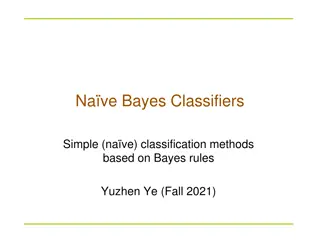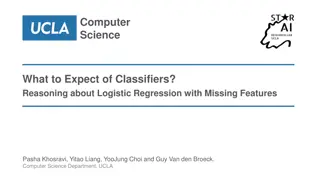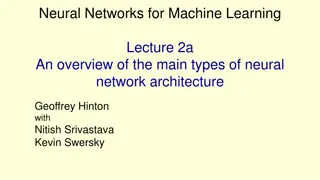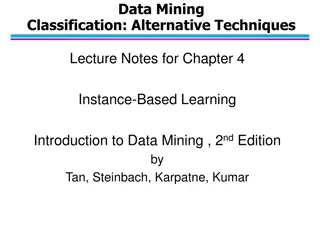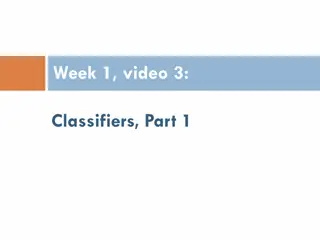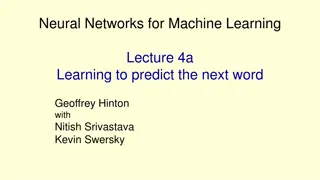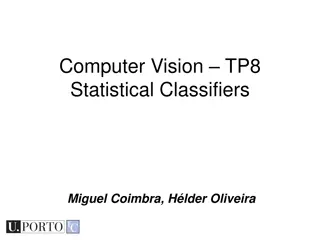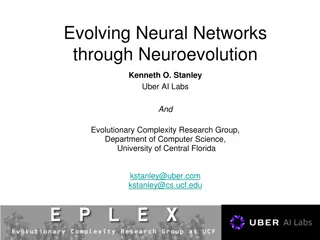Understanding Advanced Classifiers and Neural Networks
This content explores the concept of advanced classifiers like Neural Networks which compose complex relationships through combining perceptrons. It delves into the workings of the classic perceptron and how modern neural networks use more complex decision functions. The visuals provided offer a clear understanding of these concepts, from the basic perceptron to multi-layer neural networks.
Download Presentation

Please find below an Image/Link to download the presentation.
The content on the website is provided AS IS for your information and personal use only. It may not be sold, licensed, or shared on other websites without obtaining consent from the author. Download presentation by click this link. If you encounter any issues during the download, it is possible that the publisher has removed the file from their server.
E N D
Presentation Transcript
Week 1, Video 6 Advanced Classifiers
Classification There is something you want to predict ( the label ) The thing you want to predict is categorical The answer is one of a set of categories, not a number
Neural Networks Composes extremely complex relationships through combining perceptrons Finds very complicated models
The classic perceptron A perceptron takes a set of inputs Has a weight for each input Multiplies those weights by the inputs Adds it all together Adds an intercept And then applies a step function to get {0,1}
For example We have inputs M, N, P With w weights 1, 0, -0.5 and b intercept 0.1 Then for M=1, N=-7, P=2 What is f(x)?
For example We have inputs M, N, P With w weights 1, 0, -0.5 and b intercept 0.1 Then for M=-1, N=0.003, P=8 What is f(x)?
But actually Usually modern neural networks use more complex decision functions than just a step function Logistic function Tanh function ReLu function If x>0, x If x<=0, 0 And many more
Thats one perceptron And one perceptron can have multiple inputs
But But neural networks take a lot of inputs and they can produce multiple outputs Image courtesy of glosser.ca used under Creative Commons Licensing
Neural network Red circles: Predictors Blue circles: Perceptrons Green circles: Predicteds Image courtesy of glosser.ca used under Creative Commons Licensing
What you see here A single layer neural network A very simple one Generally hundreds/ thousands/millions of hidden perceptrons Image courtesy of glosser.ca used under Creative Commons Licensing
But this is just a simple single-layer neural network Image courtesy of glosser.ca used under Creative Commons Licensing
On to deep learning Image courtesy of IBM
Multiple hidden layers Image courtesy of IBM
Why does deep learning (sometimes) work better? Can capture multiple layers of abstraction Without having to do so in a way that human beings can understand
And Lots of ways to make things more complex still
Often the term deep learning Reserved for recurrent neural networks (or more complex algorithms still) Recurrent neural networks fits on sequence of events Keeping some degree of memory about previous events A different category of prediction model than classifiers that treat events as separate
Recurrent neural networks (RNN) Feed back information from later layers back to earlier layers A node can (over time) influence itself Allows for sequence of outputs
Long short term memory networks RNN variant Replaces perceptrons with LSTM units Information propagation reduces over time for given piece of information (long-term memory) Activation patterns in network change once per time step (short-term memory) Will not go into full details; linear algebra required
LSTM Unit o t o t o t T unit c t h t c t t t tanh t c t h t c t h t tanh h t h t t t t t Note the: Hidden state (h) Input gate (It) Forget gate (Ft) Output gate (Ot) Image by fdeloche - CC BY-SA 4.0
Transformer/Foundation Models BERT, MathBERT, GPT-2, GPT-3/3.5, DALL-E 2, StableDiffusion As of when m writing this slide
Transformer/Foundation Models Can predict Words Sentences Pixels Computer program text Mathematical equations Anything?
Transformer/Foundation Models Can predict Words Sentences Pixels Computer program text Mathematical equations Anything? And, in a sudden light-switch transformation, prediction becomes generation
Transformer/Foundation Models Neural networks trained on enormous data sets Enable impressive performance for new problems with minimal or even no training data AKA Zero-shot learning We will discuss them in detail in week 7 They only work for a subset of problems, but where they work it s amazing
Next Lecture eXplainable AI









